Seat belts are one of the most important safety features in your vehicle. They protect you in the event of an accident and keep you properly positioned in your seat. When a seat belt refuses to retract, it can be frustrating, and it may also compromise your safety.
If your seatbelt is slow to retract or hangs loose, it is essential to understand why this happens and what can be done to correct the issue.
How a Seat Belt Retraction System Works
Inside the seat belt assembly is a retractor mechanism that winds the belt back into its housing when you release it. This mechanism is spring-loaded, using a torsion spring to provide the tension needed to pull the belt back smoothly.
Modern retractors also have a locking mechanism that engages during sudden stops or impacts. This prevents the belt from pulling out further, holding you securely in place. When the belt is functioning normally, it retracts easily and locks only when needed.
When this system begins to fail, you may notice slow movement, sticking, or no retraction at all.
Common Reasons Seat Belts Stop Retracting
Several issues can prevent your seat belt from winding back properly. Some are simple fixes, while others require professional repair or replacement.
1. Twisted or Misaligned Webbing
If the belt is twisted or bunched up, it can create friction inside the retractor housing. This added resistance prevents the belt from sliding back easily. Straightening out the belt and removing twists may solve the problem in minor cases.
2. Dirt and Debris in the Belt
Seat belts are constantly exposed to dust, crumbs, and other debris. Over time, this buildup can cause the webbing to stick and slow down retraction. Cleaning the belt with mild soap and warm water can help restore smooth movement if dirt is the culprit.
3. Weak or Worn Retractor Spring
The torsion spring inside the retractor can weaken over time. As it loses tension, the belt no longer pulls back with the same force. Unfortunately, replacing just the spring is usually not practical, so a full retractor replacement may be necessary.
4. Damaged or Worn Webbing
If the belt itself is frayed, stretched, or damaged, it may not feed back into the housing correctly. Worn webbing can also compromise the belt’s strength, making replacement the safest option.
5. Retractor Mechanism Damage
Internal damage to the retractor from an accident or heavy impact can cause the unit to jam or lock up unnecessarily. In many cases, this will require complete replacement of the assembly to ensure proper function.
When a Slow or Stuck Belt Becomes a Safety Hazard
A belt that fails to retract properly may not be ready to secure you quickly in an accident. If it remains slack, you could be thrown forward before the belt locks in place, increasing your risk of injury.
In addition, a non-retracting belt can get caught in the door or tangled under the seat, causing further damage. That is why it is essential to address the problem as soon as you notice it, rather than waiting for it to worsen.
How to Maintain Your Seat Belts
While you cannot prevent every issue, regular care helps prolong the life of your seat belts:
- Keep the belts clean. Wash them periodically with mild soap and water, then let them air dry completely.
- Avoid slamming doors on the belt. This can crush the webbing or damage the retractor.
- Check for twists regularly and straighten them out immediately.
- Have your seat belts inspected after any accident, even a minor one.
If you follow these simple habits, your belts are more likely to operate smoothly for the long term.
Repair or Replace
Whether a seat belt can be repaired depends on the cause of the problem. Twists, dirt, and minor misalignment can often be fixed with cleaning and adjustment. However, a worn spring, frayed webbing, or damaged retractor will usually require replacement.
In most modern vehicles, seat belt retractors are integrated with other safety systems such as pretensioners, which tighten the belt in the instant before a collision. These components are sensitive and require proper installation to ensure they function correctly. This makes professional service the safest option for major repairs.
The Role of Professional Service
A qualified technician can diagnose whether the problem lies in the belt itself, the retractor mechanism, or an underlying issue with your vehicle’s safety systems. Attempting a DIY fix on a damaged retractor can be dangerous, especially if the belt is part of an advanced restraint system.
Replacing a faulty seat belt assembly restores both convenience and safety. It ensures your belt will retract properly, lock when it needs to, and give you the protection it was designed for.
Seat Belt Repair and Replacement at Maryland Auto & Truck Repair in Glen Burnie, MD
At Maryland Auto & Truck Repair in Glen Burnie, MD, we understand how vital seat belt function is for your safety. Our team can inspect your belts, identify the cause of slow or stuck retraction, and provide expert repairs or replacements as needed.
If your seat belt is not working like it should, schedule an appointment today so we can keep your vehicle’s most important safety feature ready when you need it most.










